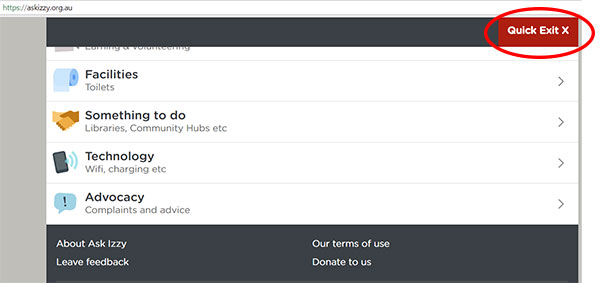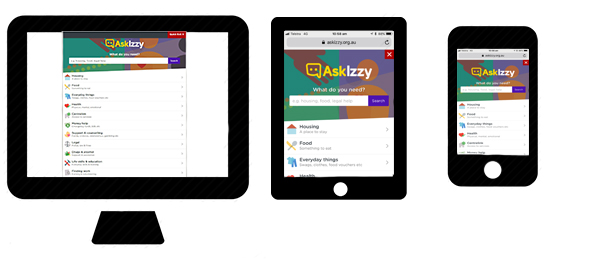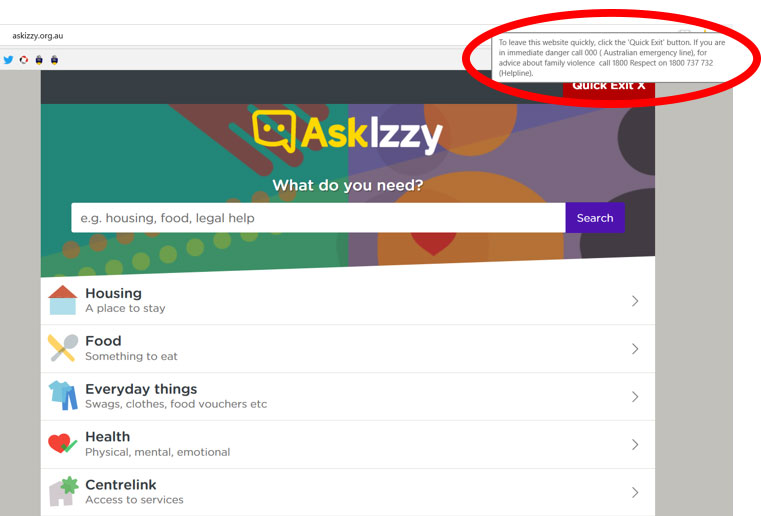
How to increase internet safety with a quick exit button
Quick exit buttons are an important element of a well-designed website that includes sensitive information, such as a family violence website.
They give users the ability to leave the site quickly, if needed, and act as a prompt that the website contains sensitive information.
This is something we’ve recently added to the Ask Izzy website to help increase safety for people at risk of or experiencing violence.
With 91 percent of households connecting to the internet through computers, laptops and mobile devices, seeking help for sensitive issues online is becoming more and more common.
Below are some of the tips we followed when creating the Ask Izzy exit button, as well as some common mistakes to avoid.
Key considerations for including a quick exit button on your website:
- Bright colour (usually red) so the button is visible on the screen.
- Always in the same position on the screen, so it is easy to find quickly.
- Moves up and down on the webpage when scrolling so the button is always visible and in the same place.

- Visible and clear on all computer, mobile and tablet devices.

- The webpage that the quick exit button directs users to loads quickly.
- On desktop, include hover text to explain what the button is or include a section to explain quick exit on the website.

Desktop computers vs Mobile phone
Looking for help online via a mobile device gives people opportunities to search at a time and place that is safer, and decreases the likelihood of someone walking in. However mobile phones have created new challenges, as they can increase the likelihood of other tech-facilitated abuse, such as GPS tracking and monitoring all internet history.
What else can be done to support online safety?
There is no one tech solution that can keep people safe or protect users against tech abuse – but education and knowledge can help people make decisions that are right for their situation. Below are some suggestions to help keep users safe.
Safe computers
Encourage the use of ‘safe computers’ for sensitive information like family violence, such as a friend’s computer or going to the library (where the perpetrator will not be able to access the device or computer). When using a safe computer it is important not to log into personal accounts that the perpetrator may have access to, e.g. Gmail
Digital literacy awareness and training
Have digital literacy and safety information available on your service’s website or at your service support centre.
Incognito tabs and information on how to clear history
Understand how to use secret browsers so there is no internet history, or information on how to delete internet history.
Strong passwords
Ensure passwords are not the same for all accounts, and have a level of complexity so a perpetrator cannot easily guess what the password is.
Resources and Training
Below are some great resources and training available from highly regarded organisations that specialise in family violence and tech abuse.
eSafety Women – information resource
Technology check up quiz with step-by-step guides, how to be safe online, information sheets for the general public (not family violence-specific). The e-Safety Commissioner has also developed information and assistance for image-based abuse or “revenge porn”.
Smart Safe – information resource
A website developed by the Domestic Violence Resource Centre Victoria (DVRCV) that is family violence specific with technology tips and guides on being safe, legal guides and videos.
Deliver training Australia-wide to family violence organisations to help workers address tech abuse with clients.
Domestic Violence Resource Centre Victoria (DVRCV) – training
Delivers training in Victoria on tech abuse, as well as many other family violence training courses.
For your tech team or web designers
Women’s Information Referral Exchange worked with design company Thick to release the code for the quick exit button (open source). This article is an interesting read for developers about designing and implementing a quick exit button.
Find out more about the Ask Izzy Help at Hand project
To keep up-to-date with the latest Ask Izzy stories, projects, events and upcoming launches, sign up to our Ask Izzy Updates quarterly enewsletter and follow us on Facebook.
If you or someone you know is experiencing issues around sexual assault, domestic or family violence or abuse, please call 1800 RESPECT (1800 737 732).

